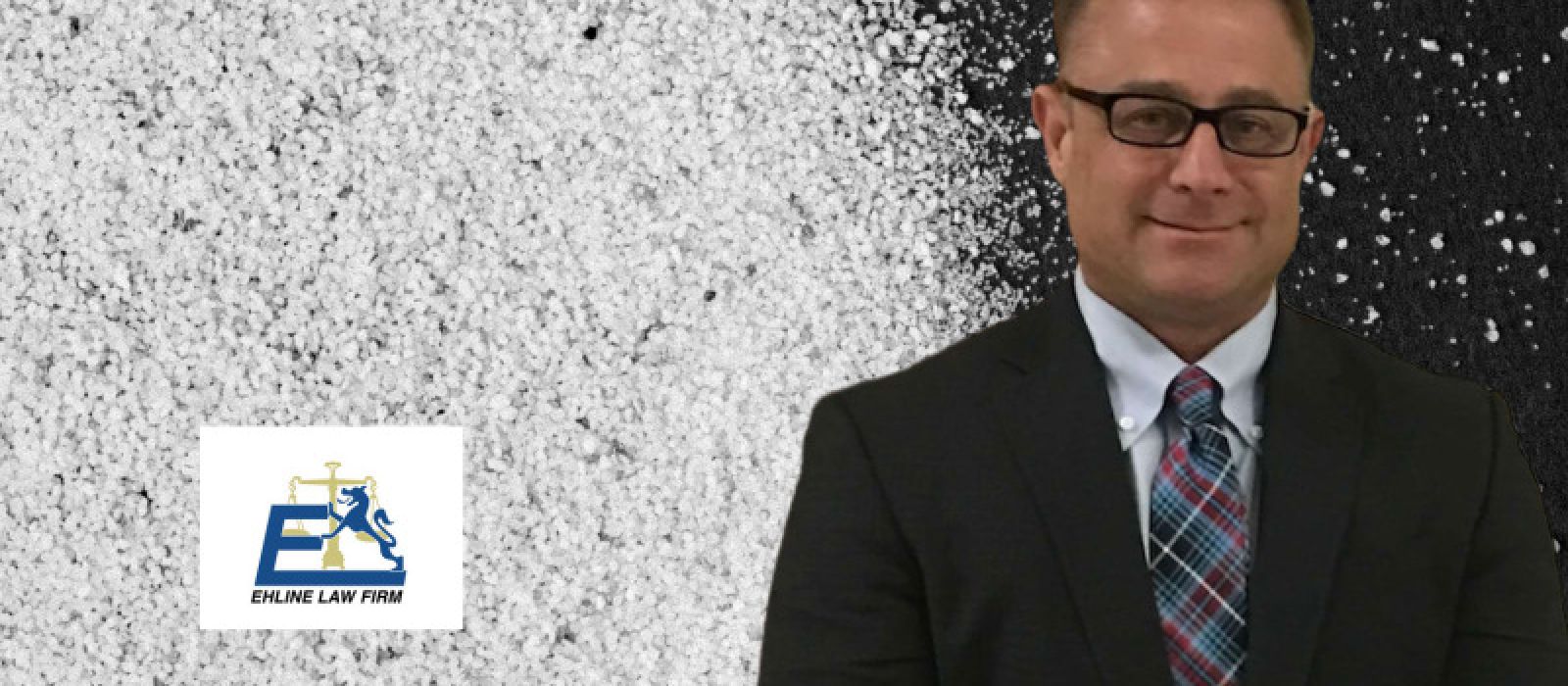

If we don’t win, you don’t pay.
NO WIN – NO FEE

ON CALL 24/7

U.S. Marine

An abundant natural mineral found in stone, soil, and sand, crystalline silica is a major raw ingredient the construction industry needs to produce bricks, artificial stone, and much more. Below, our superior personal injury attorney, Michael Ehline, will use his experience in law and as a licensed contractor in Los Angeles and Orange County, CA, to explain silica exposure claims.

It is also used to create products such as glass, pottery, and ceramics. Those working in the sand and construction industries, such as foundries or hydraulic fracturing, are often exposed to respirable crystalline silica. Exposure to toxic substances for longer durations can adversely affect a worker’s health. It can lead to serious injuries and also life-threatening illnesses.
Employees working in environments with a high risk of crystalline silica exposure do not realize that they’re suffering from the consequences of the toxic exposure until it’s too late. Some workers develop serious health conditions years after their initial silica dust exposure.
About Our Attorney Awards, Reviews, and Accolades
- The Superlawyers Rising Star Award was awarded multiple times to Michael Ehline from 2006-2015.
- Newsweek Magazine awarded its “Premier Personal Injury Attorneys” award to Ehline Law Firm’s attorneys in 2015.
- CNN interviewed Michael Ehline about cruise ship law, and he was a guest on NBC discussing limousine law practice areas. Michael was also interviewed by Nancy Grace on CBS, discussing his expertise in California dog bite law.
Our years of experience can help you hold all the negligent parties liable for causing your damages.
If you suffer from a toxic exposure injury, Ehline Law and our personal injury attorneys ensure a close attorney-client relationship to help injured victims fight for compensation. Contact us to learn more about your rights as an injured worker.
Exposure to Silica
According to the Occupational Safety and Health Administration (OSHA), silica exposure seriously threatens 2 million workers in the United States. Those working in sandblasting are at particular risk of developing silicosis, a long-term lung disease that develops from inhaling silica dust.
Occupations that have a high risk of silica exposure or jobs that expose employees to inhaling silica include coal mining, masonry workers, construction workers, stone cutting workers, and glass manufacturing workers, among many others.
Silicosis is also commonly referred to as “sandblasting disease,” and to treat it, a patient may require a lung transplant. Suppose you were exposed to dust in your work environment and are suffering from injuries due to silica inhalation. In that case, there is a high chance that you will have developed lung cancer, accelerated silicosis, or asbestosis.
It would help if you reached out to our Los Angeles silica exposure lawyer immediately to help you recover the compensation you deserve.
Types of Silicosis and Symptoms
There are three main types of silicosis, and they are:
- Acute silicosis: This occurs when there is exposure to large amounts of silica over a short period. The lungs experience severe inflammation making breathing difficult and causing shortness of breath. Since there is low oxygen intake, it results in low blood oxygen levels. The patient may also experience tiredness, weight loss, and even start to have a cough.
- Chronic silicosis occurs when silica is exposed over a long period, often 20 years or more. The silica dust builds up in the lungs causing swelling in the lungs and chest lymph nodes. It is the most common type of silicosis among workers working in an environment exposed to silica dust. Symptoms start mild but slowly start to become worse. People with chronic silicosis start to develop dyspnea during exertion, which transitions to dyspnea during rest. In addition, the patient may have a productive cough and advanced conditions such as chronic obstructive pulmonary disease and respiratory failure.
- Accelerated silicosis: Workers exposed to large amounts of silica over ten years develop accelerated silicosis, which is often present in workers directly handling silica or engineered stone. It is difficult to diagnose early on, and symptoms include severe shortness of breath, fatigue, and weight loss.
Diagnosing Silicosis
Several medical tests allow medical professionals to diagnose silicosis, and these include:
- Chest x-ray: An x-ray helps medical professionals look for scars or spots on the lungs.
- Bronchoscopy: A doctor may run a thin tube with a tiny camera at the end of it down the throat and into the patient’s lungs to identify the signs and extent of internal damage.
- Biopsy: A lung tissue biopsy involves a medical professional inserting a needle into the patient’s chest and collecting a nodule sample from their lungs. That is then run under a microscope and checked for signs of silicosis.
- Sputum test: Since there is a chance of other types of infections arising from silicosis, the sputum tests help identify those infections, including tuberculosis.
Treatment of Silicosis
Depending on the severity of the silicosis, the treatments may vary, and some of these include:
- Staying away from further silica exposure.
- Symptomatic treatment.
- Oral corticosteroids.
- Lung transplant (in extreme cases).
Patients suffering from blocked airways that cause shortness of breath may receive corticosteroids, an effective anti-inflammatory steroid hormone. Medical professionals will also treat any secondary condition arising from silicosis to prevent complications and life-threatening situations.
Prevention of Silicosis
Preventing silicosis should start at the industrial level, at workplaces where employees are more exposed to silica than others. Employers must provide their employees with the necessary gear to prevent inhalation of silica dust, such as respiratory masks. Employers must also ensure that the workplace has enough ventilation to reduce the amount of silica inhaled by employees while working.
Workplaces should also focus on employee surveillance, where they frequently question employees about their health conditions and require them to get chest X-rays done. The quicker employees know of their health condition, the faster they can start medical treatment.
Employees exposed to silica can also develop tuberculosis or non-tuberculosis mycobacterial infections. It is important to create awareness about the condition to educate the employees on the risk of inhaling silica dust.
Silica dust can also accumulate on the worker’s clothes, which is why wearing disposable or washable work clothes is also recommended. Before leaving the work site, workers must vacuum their clothes to remove any silica dust.
Liability for Silicosis from Extended Exposure
Anyone exposed to silica dust may be eligible to file a lawsuit. Depending on the situation, multiple parties may be involved in your medical condition. The injuries can be mild, all the way to wrongful death.
Individuals may pursue legal action against one or more of the following:
Manufacturers
Individuals suffering from silicosis due to faulty products or safety gear may be able to hold the manufacturer of the product or tool responsible for their illness. They may sue the manufacturer for negligence, defective product design, or even breach of warranty.
Negligent Employers
Suppose an employer forces an employee to work in unsafe working conditions without providing adequate safety gear and protection. In that case, they may be responsible for the employee’s injuries after exposure to silica. The employee may have grounds to recover compensation from their employer.
It is important to speak to our Los Angeles personal injury attorney to determine whether there is a liability and hold the responsible parties accountable for your loss. Besides compensatory damages, plaintiffs can also file a lawsuit to punish the negligent parties and recover punitive damages.
Statute of Limitations for Silica Exposure Cases
The statute of limitations allows personal injury victims two years to pursue claims against negligent parties following the accident date. However, a toxic exposure case is much different than a personal injury case, as injuries from silica exposure can manifest over a long period, which is why the statute of limitations does not apply.
According to the Code of Civil Procedure 340.8, California residents must file a lawsuit against the negligent party within two years of the injury or after identifying that the injury caused was due to another’s negligence.
Schedule a Free Consultation with Ehline Law Silica Exposure Injury Attorneys
Exposure to silica can devastate the victim and their family’s lives, especially if the injured victim is the sole breadwinner. If you suffered silica injuries due to another’s negligence, contact us at + (833) LETS-SUE for a free consultation with our personal injury lawyers for legal advice. Use our convenient online contact us form for email communications.

